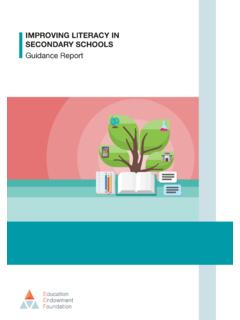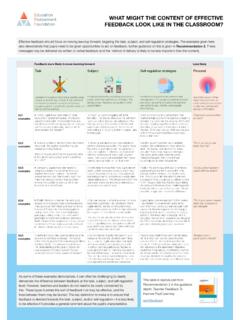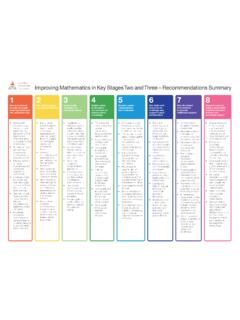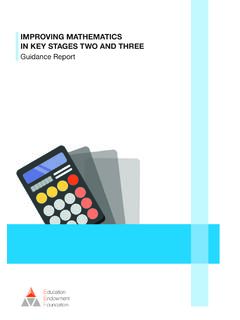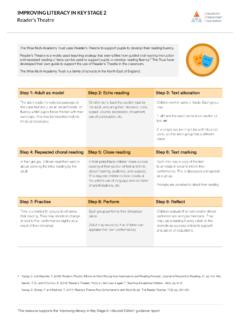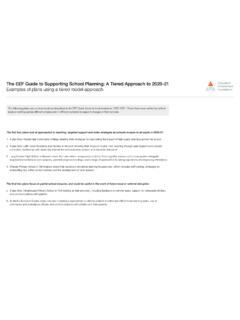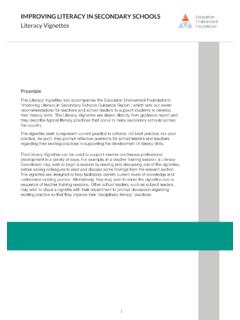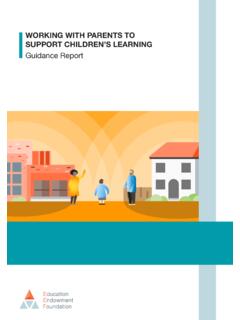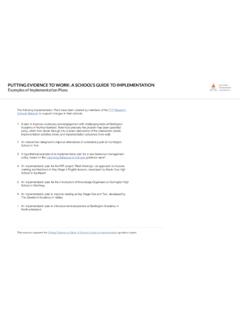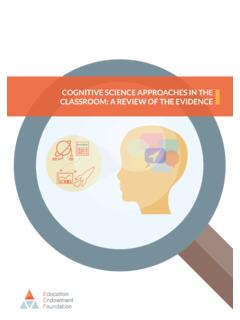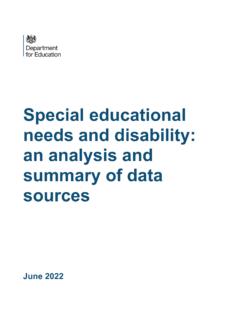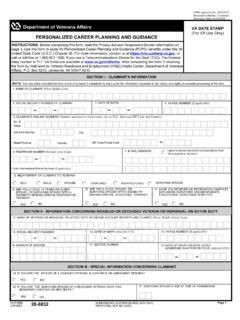Transcription of SPECIAL EDUCATIONAL NEEDS IN MAINSTREAM SCHOOLS
1 Guidance ReportSPECIAL EDUCATIONAL NEEDS IN MAINSTREAM SCHOOLSE ducation Endowment Foundation The authors would like to thank the many researchers and practitioners who provided support and feedback on drafts of this guidance. In particular we would like to thank the Advisory Panel and Evidence Review Group:Advisory Panel: Adam Boddison, Julia Carroll, Maria Constantinou, Mairi-Ann Cullen, Geoff Lindsay, Margaret Mulholland, Christine Oliver, and Rebecca Review Group: Mairi Ann Cullen, Geoff Lindsay, Richard Hastings, Louise Denne and Catherine Reviewers: Lorena Beqiraj, Farah Elahi, Eli Gemegah, Nikita Hayden, Ines Kander, Foteini Lykomitrou and Julia report authors: Kath Davies and Peter the Education Endowment FoundationThe Education Endowment Foundation (EEF)
2 Is an independent charity supporting teachers and school leaders to use evidence of what works and what doesn t to improve EDUCATIONAL outcomes, especially for disadvantaged children and young guidance report was produced with the financial support of The Kusuma Trust EDUCATIONAL NEEDS in MAINSTREAM Schools1 CONTENTSF oreword 2 Introduction 3 Summary of recommendations 8 Recommendation 1 Create a positive and supportive environment for all pupils, without exception 10 Recommendation 2 Build an ongoing, holistic understanding of your pupils and their needs14 Recommendation 3 Ensure all pupils have access to high quality teaching20 Recommendation 4 Complement high quality teaching with carefully selected small-group and one-to-one interventions 28 Recommendation 5 Work effectively with teaching assistants34 References 38 How was this guidance compiled?
3 412 Education Endowment Foundation Education professionals are usually driven by the desire to provide each and every young person with the best chance to succeed in life, no matter who they are or where they come from. Our aim at the EEF is to support professionals by arming them with the tools needed to make the biggest possible impact in achieving this. This is especially crucial for those pupils that need the most with SPECIAL EDUCATIONAL NEEDS and disability (SEND) have the greatest need for excellent teaching and are entitled to provision that supports achievement at, and enjoyment of, school. The attainment gap between pupils with SEND and their peers is twice as big as the gap between pupils eligible for free school meals and their peers.
4 However, pupils with SEND are also more than twice as likely to be eligible for free school for us, closing the disadvantage gap means finding better ways to support pupils with SEND. The challenge is compounded by the complexity of the system of which SCHOOLS are only one part. The best provision for pupils with SEND requires coordination across multiple organisations and individuals made harder in recent years by spending pressures. The professional challenge of supporting pupils with SEND is both practical and principled. This is why we ve developed this guidance report. It offers five evidence-based recommendations to support pupils with SEND, providing a starting point for SCHOOLS to review their current approach and practical ideas they can implement.
5 To develop the recommendations in this report, we reviewed the best available international research and consulted with teachers and other overriding message from the report is a positive one. It is tempting to talk about the challenge of SEND as a specific and distinct issue. Yet, far from creating new programmes, the evidence tells us that teachers should instead prioritise familiar but powerful strategies, like scaffolding and explicit instruction, to support their pupils with SEND. This means understanding the NEEDS of individual pupils and weaving specific approaches into everyday, high-quality classroom teaching being inclusive by design not as an afterthought. It also means using carefully implemented interventions and working effectively with teaching assistants to offer additional support where with all our guidance reports, this publication is just the start.
6 We will now be working with the sector, including through our colleagues in the Research SCHOOLS Network, to build on the recommendations with further training, resources, and guidance. By engaging with professionals to deliver a research-led approach we can realise our mutual aim to support the attainment and life-chances of some of our most vulnerable pupils. Professor Becky FrancisChief ExecutiveEducation Endowment Foundation Closing the disadvantage gap means finding better ways to support pupils with SEND. FOREWORD50 40302010 0 Average Attainment 8 score per pupilPupils with SENP upils eligible for FSMO ther Pupils3 SPECIAL EDUCATIONAL NEEDS in MAINSTREAM Schools3 INTRODUCTIONWhat does this guidance cover? This report presents five recommendations for MAINSTREAM primary and secondary SCHOOLS seeking to improve their provision for pupils with SEND.
7 Some of the recommendations included here will also be helpful for pupils in SPECIAL SCHOOLS , although we recognise that the approaches might need to be adapted and supplemented with specialist support for pupils with profound learning NEEDS . The EEF is currently considering how it can support SPECIAL SCHOOLS in the future with tailored guidance and term SEND is used throughout the report in order to be inclusive of all pupils with these NEEDS and in recognition of the fact that a disability will often overlap with SPECIAL EDUCATIONAL NEEDS . However, this report is about SPECIAL EDUCATIONAL NEEDS and provision rather than any adaptations SCHOOLS may need to make for pupils with a physical disability or a long-term health condition.
8 The focus is on improving the quality of teaching and learning in MAINSTREAM classrooms and ensuring pupils are full members of the school community who have a rich and positive experience. We have taken a pragmatic approach not every issue relevant to pupils with SEND will be covered in detail. The guidance does not address the complexities around funding or availability of specialist provision, nor does it focus on types of need or conditions. Those issues are of course important, but beyond the scope of this report. Instead, we have focused on five key recommendations that should be the focus for school improvement. The aim is to give an overview of some key best bets for improving SPECIAL EDUCATIONAL provision. In many cases, the advice here overlaps with other EEF guidance reports such as Metacognition and Self-regulated Learning.
9 We strongly recommend that SCHOOLS consider other EEF guidance reports when planning their SEND provision. This guidance is based on a focused review of the best available evidence on improving outcomes for pupils with SEND in MAINSTREAM SCHOOLS . The review focused on research related to pupils aged 5 16. It was undertaken by the Centre for EDUCATIONAL Development, Appraisal and Research (CEDAR) at the University of Who is this guidance for? This guidance is for school leaders, including the SPECIAL EDUCATIONAL NEEDS Coordinator (SENCo), and classroom teachers across MAINSTREAM primary and secondary SCHOOLS . This guidance challenges the idea that responsibility for SPECIAL EDUCATIONAL NEEDS is solely the job of the SENCo.
10 The SENCo has an important role in the development of a school s approach, but ensuring all pupils achieve including those with SEND is everyone s responsibility. If the SENCo takes sole responsibility, there is a risk of de-skilling school leaders and classroom teachers who can subsequently lose confidence in supporting pupils with SEND. We hope that this guidance can empower the classroom teacher by demonstrating that many of the skills required are those they are already developing in their teaching for all pupils. There are additional audiences who might find this guidance useful. School governors can use the guidance to support and challenge their school leadership on SEND. Parents, carers, and families may find the guidance useful to inform their interactions with SCHOOLS .
